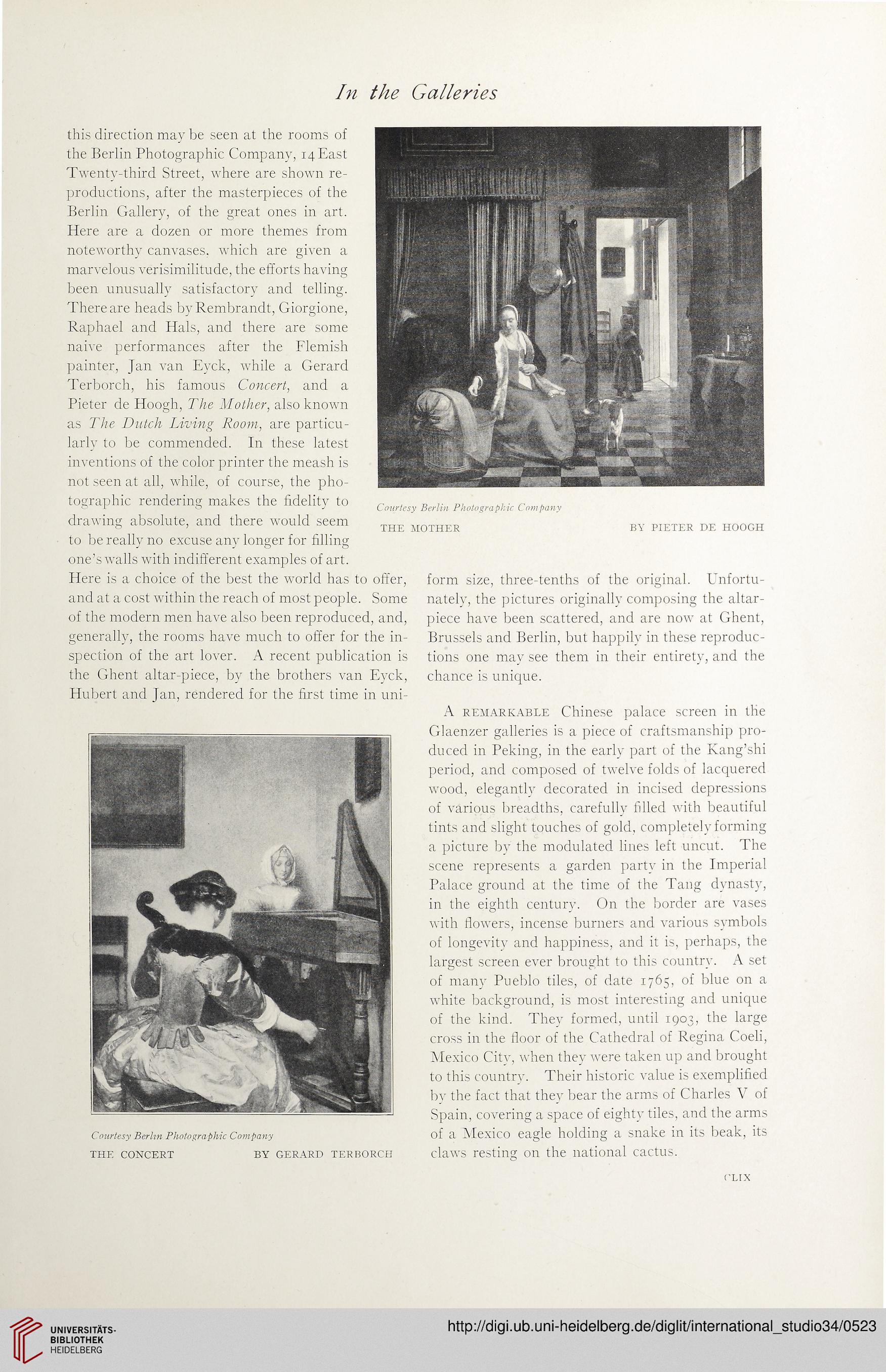In the Galleries
Courtesy Berlin Photographic Company
THE MOTHER BY PIETER DE HOOGH
this direction may be seen at the rooms of
the Berlin Photographic Company, 14 East
Twenty-third Street, where are shown re-
productions, after the masterpieces of the
Berlin Gallery, of the great ones in art.
Here are a dozen or more themes from
noteworthy canvases, which are given a
marvelous verisimilitude, the efforts having
been unusually satisfactory and telling.
There are heads by Rembrandt, Giorgione,
Raphael and Hals, and there are some
naive performances after the Flemish
painter, Jan van Eyck, while a Gerard
Terborch, his famous Concert, and a
Pieter de Hoogh, The Mother, also known
as The Dutch Living Room, are particu-
larly to be commended. In these latest
inventions of the color printer the meash is
not seen at all, while, of course, the pho-
tographic rendering makes the fidelity to
drawing absolute, and there would seem
to be really no excuse any longer for filling
one’s walls with indifferent examples of art.
Here is a choice of the best the world has to offer,
and at a cost within the reach of most people. Some
of the modern men have also been reproduced, and,
generally, the rooms have much to offer for the in-
spection of the art lover. A recent publication is
the Ghent altar-piece, by the brothers van Eyck,
Hubert and Jan, rendered for the first time in uni-
Ccurtesy Berlin Photographic Company
THE CONCERT BY GERARD TERBORCH
form size, three-tenths of the original. Unfortu-
nately, the pictures originally composing the altar-
piece have been scattered, and are now at Ghent,
Brussels and Berlin, but happily in these reproduc-
tions one may see them in their entirety, and the
chance is unique.
A remarkable Chinese palace screen in the
Glaenzer galleries is a piece of craftsmanship pro-
duced in Peking, in the early part of the Ivang’shi
period, and composed of twelve folds of lacquered
wood, elegantly decorated in incised depressions
of various breadths, carefully tilled with beautiful
tints and slight touches of gold, completely forming
a picture by the modulated lines left uncut. The
scene represents a garden party in the Imperial
Palace ground at the time of the Tang dynasty,
in the eighth century. On the border are vases
with flowers, incense burners and various symbols
of longevity and happiness, and it is, perhaps, the
largest screen ever brought to this country. A set
of many Pueblo tiles, of date 1765, of blue on a
white background, is most interesting and unique
of the kind. They formed, until 1903, the large
cross in the floor of the Cathedral of Regina Coeli,
Mexico City, when they were taken up and brought
to this country. Their historic value is exemplified
by the fact that they bear the arms of Charles V of
Spain, covering a space of eighty tiles, and the arms
of a Mexico eagle holding a snake in its beak, its
claws resting on the national cactus.
CLIX
Courtesy Berlin Photographic Company
THE MOTHER BY PIETER DE HOOGH
this direction may be seen at the rooms of
the Berlin Photographic Company, 14 East
Twenty-third Street, where are shown re-
productions, after the masterpieces of the
Berlin Gallery, of the great ones in art.
Here are a dozen or more themes from
noteworthy canvases, which are given a
marvelous verisimilitude, the efforts having
been unusually satisfactory and telling.
There are heads by Rembrandt, Giorgione,
Raphael and Hals, and there are some
naive performances after the Flemish
painter, Jan van Eyck, while a Gerard
Terborch, his famous Concert, and a
Pieter de Hoogh, The Mother, also known
as The Dutch Living Room, are particu-
larly to be commended. In these latest
inventions of the color printer the meash is
not seen at all, while, of course, the pho-
tographic rendering makes the fidelity to
drawing absolute, and there would seem
to be really no excuse any longer for filling
one’s walls with indifferent examples of art.
Here is a choice of the best the world has to offer,
and at a cost within the reach of most people. Some
of the modern men have also been reproduced, and,
generally, the rooms have much to offer for the in-
spection of the art lover. A recent publication is
the Ghent altar-piece, by the brothers van Eyck,
Hubert and Jan, rendered for the first time in uni-
Ccurtesy Berlin Photographic Company
THE CONCERT BY GERARD TERBORCH
form size, three-tenths of the original. Unfortu-
nately, the pictures originally composing the altar-
piece have been scattered, and are now at Ghent,
Brussels and Berlin, but happily in these reproduc-
tions one may see them in their entirety, and the
chance is unique.
A remarkable Chinese palace screen in the
Glaenzer galleries is a piece of craftsmanship pro-
duced in Peking, in the early part of the Ivang’shi
period, and composed of twelve folds of lacquered
wood, elegantly decorated in incised depressions
of various breadths, carefully tilled with beautiful
tints and slight touches of gold, completely forming
a picture by the modulated lines left uncut. The
scene represents a garden party in the Imperial
Palace ground at the time of the Tang dynasty,
in the eighth century. On the border are vases
with flowers, incense burners and various symbols
of longevity and happiness, and it is, perhaps, the
largest screen ever brought to this country. A set
of many Pueblo tiles, of date 1765, of blue on a
white background, is most interesting and unique
of the kind. They formed, until 1903, the large
cross in the floor of the Cathedral of Regina Coeli,
Mexico City, when they were taken up and brought
to this country. Their historic value is exemplified
by the fact that they bear the arms of Charles V of
Spain, covering a space of eighty tiles, and the arms
of a Mexico eagle holding a snake in its beak, its
claws resting on the national cactus.
CLIX




